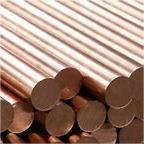1. Introduction
Just 24 hours ago, a major solar farm in Texas reported a lightning-induced system failure that could have been prevented with upgraded earthing infrastructure—highlighting the urgent need for reliable grounding solutions in renewable energy projects. As clean energy installations expand globally, engineers are turning to specialized conductive materials like copper rod to ensure safety, compliance, and longevity.

Among these, the humble copper rod plays a surprisingly sophisticated role—not just as raw material, but as a precision-engineered component in advanced earthing systems. This article dives into how copper rods, especially copper earth rods and copper-bonded variants, are becoming indispensable in modern renewable energy farms.
2. The Role of Copper Rods in Renewable Energy Earthing
Grounding is non-negotiable in solar and wind installations. These sites often span vast, exposed areas vulnerable to lightning strikes and electrical faults. A robust earthing system dissipates dangerous currents safely into the earth, protecting both equipment and personnel.
2.1. Why Copper Earth Rods?
Pure copper earth rods offer exceptional electrical conductivity and long-term corrosion resistance—critical in harsh outdoor environments. Unlike alternatives, solid copper rods maintain integrity over decades, even in acidic or saline soils.
However, due to cost, many projects now opt for copper bonded earthing rods. These consist of a steel core electroplated with a thick layer of copper (typically 0.25mm or more), combining the strength of steel with the conductivity and corrosion resistance of copper.
- Copper bonded ground rod: ideal balance of durability and cost
- Copper clad steel earth rod: similar concept, but uses metallurgical bonding instead of electroplating
- Solid copper rod: used in highly corrosive or critical applications

2.2. Compatibility with Copper Strips and Bus Bars
Once the ground rod is installed, it must connect to the facility’s grounding network—often made of flat copper strip or flexible copper bus bar. Copper strip for earthing (e.g., 25x3mm) provides low-resistance pathways across panels and inverters.
Technicians frequently use copper to copper brazing rods or copper welding rod to join these components. Copper rod welding ensures seamless, high-conductivity joints without galvanic corrosion—especially important when linking a copper bonded steel ground rod to a pure copper strip.
Common materials in these networks include nickel plated copper strip for added oxidation resistance and beryllium copper strip in high-stress mechanical connections.
3. Practical Considerations: Cost, Installation, and Sourcing
While performance matters, budget constraints influence material choices. The earthing rod price varies significantly: solid copper rods cost more than copper bonded or copper clad steel ground rods. For large farms, this difference can amount to tens of thousands of dollars.
Yet, lifecycle cost often favors higher-quality materials. A corroded ground rod compromises the entire system—a risk no operator can afford.

3.1. Pricing and Availability
Current market trends show stable copper rod price levels despite global metal fluctuations. Buyers often search for ‘copper rod near me’ or ‘copper strip near me’ to reduce shipping costs on heavy conductors.
Popular items include:
- Copper earth strip 25x3mm price: typically $8–$12 per meter
- Copper bonded earthing rod (16mm x 3m): $40–$70 each
- Roll of copper strip (1mm thick, 25mm wide): widely stocked for custom runs
3.2. Installation Best Practices
Driving a copper earth rod deep into soil (often 3m or more) ensures low earth resistance. In rocky terrain, multiple shorter rods connected via copper strip create an effective grid.
Connections must be exothermically welded or brazed using copper to copper welding rod—not clamped—to prevent loosening over time. Copper brazing rod is preferred for its high melting point and strong joint integrity.
4. Beyond Earthing: Other Niche Uses of Copper Rod in Energy Systems
While earthing dominates, copper rods also serve in auxiliary roles. For instance, copper round bar is machined into custom bus bars for DC combiner boxes. Flexible copper bar variants accommodate thermal expansion in outdoor enclosures.
In some hybrid systems, thin copper strips act as thermal interfaces or EMI shields—showcasing the versatility of copper beyond conduction alone.
5. Conclusion
From preventing catastrophic failures to ensuring regulatory compliance, the copper rod—whether solid, bonded, or clad—is far more than a simple metal stick. In the booming renewable energy sector, its role in advanced earthing systems is both foundational and forward-looking. As farms grow larger and smarter, the demand for high-performance copper-based grounding components like earthing rod copper and copper strip for earthing will only rise.
Our Website founded on October 17, 2012, is a high-tech enterprise committed to the research and development, production, processing, sales and technical services of ceramic relative materials such as Why. Our products includes but not limited to Boron Carbide Ceramic Products, Boron Nitride Ceramic Products, Silicon Carbide Ceramic Products, Silicon Nitride Ceramic Products, Zirconium Dioxide Ceramic Products, etc. If you are interested, please feel free to contact us.

